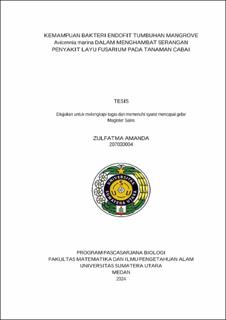| dc.description.abstract | Mangroves are known to have special abilities to adapt and grow in extreme environmental conditions. Mangroves have been reported to harbor endophytic bacteria that have potential as biological control agents. Additionally, efforts to control Fusarium wilt disease in plants caused by Fusarium oxysporum are currently ongoing, including the use of environmentally friendly biological control agents such as endophytic microbes. Based on this potential and these issues, research was conducted aiming to obtain and identify endophytic bacterial isolates from the roots of Avicennia marina mangroves that have the ability to solubilize phosphate, produce indole acetic acid (IAA), and act as antagonists against Fusarium wilt disease when applied to chili plants. Fifteen endophytic bacterial isolates were obtained from the roots of Avicennia marina mangroves growing in peat, sandy, and submerged in seawater environments. In vitro testing revealed two potential phosphate-solubilizing bacterial isolates, MB10S3 and MB11S3, with phosphate solubilization indices of 16.2 and 9.5, respectively. Testing for inhibition of F. oxysporum fungus using dual culture disc method identified three potential isolates, MB3S1, MB4S1, and MB10S3, with inhibition zone diameters of 1.7 mm, 4.5 mm, and 2.5 mm, respectively. Testing for IAA production using calorimetric method identified two potential isolates, MB3S1 and MB8S2, producing IAA concentrations of 60.79 ppm and 58.58 ppm, respectively. Application of these five potential isolates on chili seedlings to inhibit F. oxysporum showed that MB3S1 performed well in inhibiting the disease, reducing the disease severity to only 18.47% (mild). Molecular identification results indicated that isolate MB3S1 was identified as Paenibacillus thiaminolyticus strain SMC307 with a similarity of 96%. | en_US |


